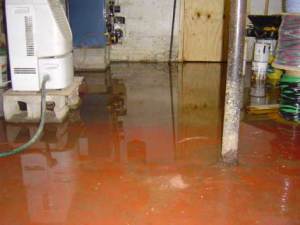Basement flooding cleanup San Francisco
 Basements are convenient areas for storage, but are very vulnerable to flooding. There are numerous causes of basement flooding, from torrential storms, hurricanes, and prolonged rainfall to leakage due to plumbing problems, lack of effective gutters, cracked exterior surfaces, clogged foundation drains, plant or trees too close to the foundation walls, or improper exterior grading along the foundation’s perimeter.
Basements are convenient areas for storage, but are very vulnerable to flooding. There are numerous causes of basement flooding, from torrential storms, hurricanes, and prolonged rainfall to leakage due to plumbing problems, lack of effective gutters, cracked exterior surfaces, clogged foundation drains, plant or trees too close to the foundation walls, or improper exterior grading along the foundation’s perimeter.
Since there are so many possible causes for flooding, it may be a good idea to have your basement inspected by professionals to determine the exact causes of the flooding, as repairs to the foundation or plumbing might be necessary to prevent future flooding.
Act Quickly to Clean Up
Basement flooding cleanup must be done as soon as possible. There are a number of serious concerns with having a flooded basement. In addition to the possible long-term structural damage, there is immediate danger of electric shock and possible contamination from mold, which can cause health problems such as respiratory infections, eye irritation, skin rashes, asthma and even lung disease, depending on the type and toxicity of mold.
Before beginning any cleanup, make absolutely sure the electricity is turned off. If the flooding is severe, it is safer to get a licensed electrician to check your building for any potential danger. Also ensure that natural gas, propane or fuel oil valves are turned off. Begin ventilation by opening all doors and windows to get a flow of air coming into the basement and use large fans to disperse fumes. Next, put on protective gear such as waterproof boots, rubber gloves and a face mask.
Step 1: Remove Damaged Items
All furniture, rugs and water-damaged items must be taken outside the basement to dry. If there are photographs or papers that are important to keep, they need to be dried slowly. Take rugs outside to hose them down, then disinfect with carpet cleaner.
Step 2: Pump Out the Water
Wait for the floodwaters to recede before pumping your basement, or else the outside water pressure can cause the foundation walls to cave in. It is best to remove about two to three feet of water of water per day to prevent this.
For minor flooding, portable pumps fitted with a drain hose can be used to get the water out of the basement. For more extensive flooding, it may be better to call in professionals who have experience with water damage and the proper equipment to clean the basement thoroughly and safely.
Step 3: Dry and Dehumidify
For the remaining puddles, use a wet/dry shop vacuum, floor squeegee or mop. Keep going until all the standing water is gone. If your basement has concrete floors, they can still retain quite a bit of water due to the porous nature of concrete. If you have wooden floors, they must be dried very slowly or there is danger of splitting and cracking. Water can also cause wood to swell and buckle. Run a dehumidifier continuously for several days and run fans for at least 24 hours.
If you do not have enough fans and dehumidifiers to properly dry out the basement, contact a professional to get the job done faster, since the longer the moisture is there, the greater the chance that mold will start to grow.
Step 4: Clean and Disinfect
Dirt can trap mold spores, so it is vital to clean and disinfect all surfaces. Once the basement is completely dry, every area that was wet must be scrubbed with a solution of one cup of bleach and five gallons of water.
